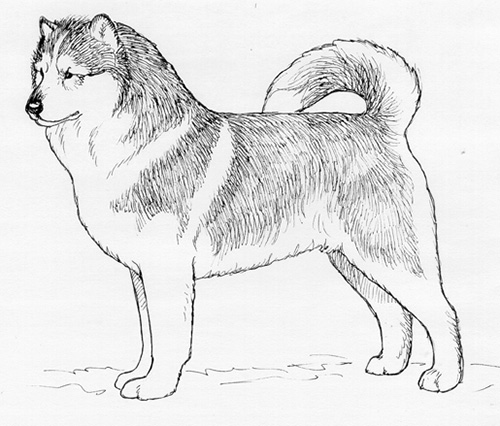Greenland Dog
Northern Breed Group
The goals and purposes of this breed standard include: to furnish guidelines for breeders who wish to maintain the quality of their breed and to improve it; to advance this breed to a state of similarity throughout the world; and to act as a guide for judges.
Breeders and judges have the responsibility to avoid any conditions or exaggerations that are detrimental to the health, welfare, essence and soundness of this breed, and must take the responsibility to see that these are not perpetuated.
Any departure from the following should be considered a fault, and the seriousness with which the fault should be regarded should be in exact proportion to its degree and its effect upon the health and welfare of the dog and on the dog’s ability to perform its traditional work.
History
The Greenland Dog is one of the world’s oldest breeds, having been used by the Eskimos since ancient times as both a hunting and a transportation dog. Dogs selected for breeding were always evaluated for their strength, sturdiness and endurance, but an attractive appearance was also kept in mind.
The Greenland Dog was recognized by the United Kennel Club January 1, 1996.
General Appearance
A very strong, polar type Spitz breed, built for endurance and strenuous work as a sledge dog in difficult Arctic conditions. Some variation in size is allowable as long as working ability and balance are not compromised.
Characteristics
The predominant temperament qualities of the Greenland Dog are energy, mental strength and boldness. He is a tireless sled dog and while friendly to people, he is not particularly attached to any one person and not suitable as a guard dog. The breed has a strong instinct for hunting polar bear and seal.
Fault: Timid temperament.
Head
SKULL
The skull is slightly arched and broadest between the ears. The stop is definite, but not abrupt.
MUZZLE
Wedge shaped, broad at the base and tapering towards the nose, but never pointed. The nasal bridge is straight and broad from the stop to the nose. The lips are thin and tight.
TEETH
The Greenland Dog has a complete set of evenly spaced, white teeth meeting in a
scissors bite. NOSE
Large and dark, corresponding to the color of the coat. In red or gold dogs, the nose is often liver. Snow nose is not a fault.
EYES
Dark eyes are preferred, but eyes that match lighter colored coats are acceptable. The eyes are set obliquely and are neither sunken nor protruding. Lids are tight fitting. The expression is frank and bold.
Disqualifications: Eyes of different colors. Wall eyes.
EARS
Rather small and triangular in shape, with rounded tips. The ears are carried firmly erect, and are very mobile and expressive.
Serious Fault: Ears not carried firmly erect.
Neck
Very powerful and rather short.
Forequarters
The shoulder blades are moderately laid back. The upper arm is straight and strong, somewhat longer than the shoulder blade.
FORELEGS
Perfectly straight, with strong muscles and heavy bone. The elbows fit close to the body, but have free action. The carpal joint is strong and flexible, and the pastern is strong and elastic and only slightly sloping.
Fault: Fine in bone.
Body
The body is strong and rather compact, just slightly longer that the height at the withers. The chest is deep and broad, but the ribs are not barrel shaped. The back is straight, and the topline is level or just slightly sloping. The loin is broad, and the croup is slightly sloping. The belly follows the natural line of the brisket, but a slight tuck up is allowed.
Fault: Low on leg.
Hindquarters
The hindquarters are moderately angulated and very muscular.
HIND LEGS
Perfectly straight when seen from behind. The bone is powerful and the thighs are muscular. The hock is broad and strong with moderate angulation.
Fault: Fine in bone.
Feet
Rather large, powerful and rounded, with strong nails and pads.
Tail
Set on high, thick and bushy. Carried in a curve or lightly curled over the back.
Coat
Double, with a dense, straight, coarse outer coat and a soft undercoat. No curl or wave. On the head and legs, the hair is rather short; on the body it is longer and more generous. The coat is long on the tail, giving it a bushy appearance.
Serious Fault: Long, soft coat.
Color
Any color is permissible.
Weight
Height for males is 23.5 inches and upwards. For females, it is 21.5 inches and upwards.
Gait
An efficient, harmonious, fluid and tireless trot is essential to a sledge dog. In the ring, the breed should be shown on a loose lead at a moderate trot to display good reach and drive. The breed does not single track, but will tend to converge toward a center line when speed is increased.
Disqualifications
(A dog with a Disqualification must not be considered for placement in a conformation event, and must be reported to UKC.)
Unilateral or bilateral cryptorchid.
Viciousness or extreme shyness.
Albinism.
Eyes of different colors.
Wall eyes.

Looking for a Dog?
Find a dog that will fit your family.
Note: The breeders on this list are not endorsed by UKC.
©Copyright 1996, United Kennel Club
